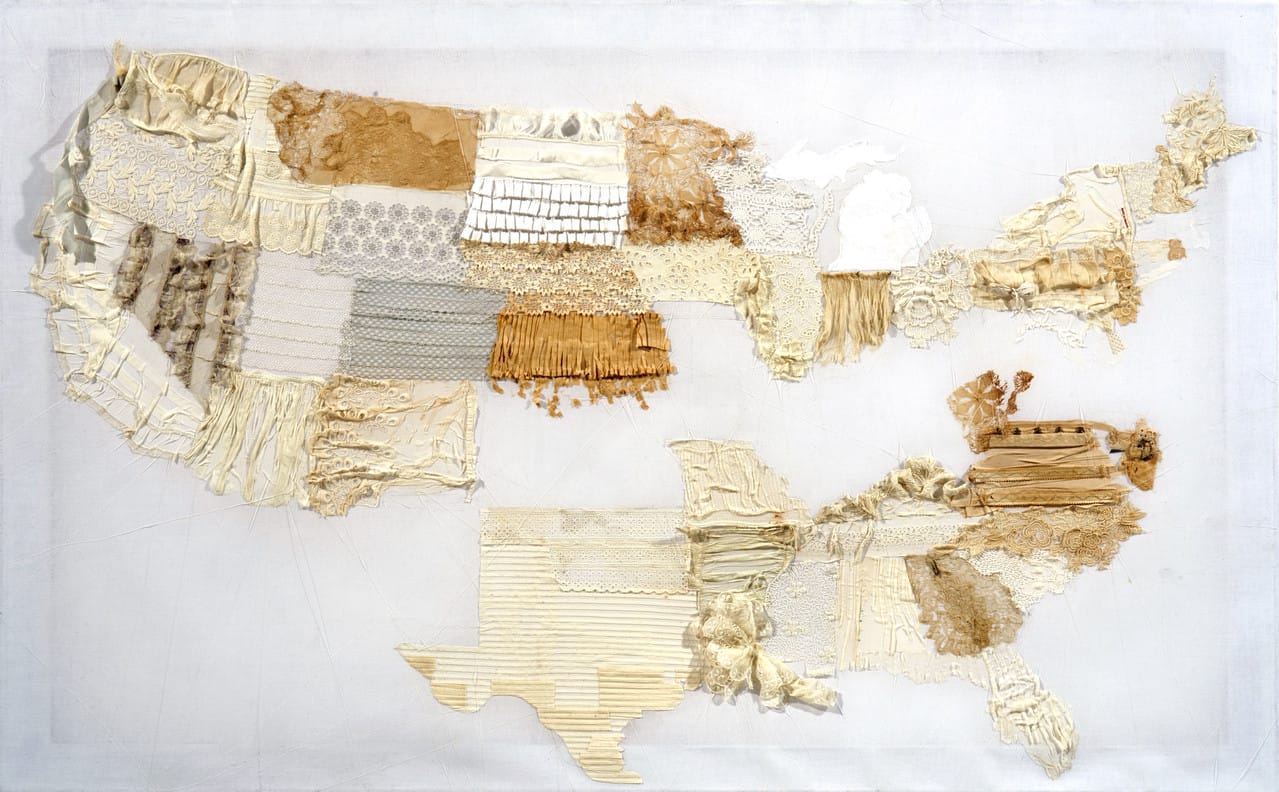CYNTHIA AURORA BRANNVALL – The Threads That Bind
MoAD Museum of African Diaspora, 685 Mission St. (at 3rd), San Francisco, CA 94105
March 30, 2022 – June 12, 2022
Info www.moadsf.org
Curated by Elena Gross
MoAD Emerging Artists presents The Threads that Bind, an exhibition proposal that engage with textiles centered on themes of cultural and historical memory in relation to black diasporic experience and identity formation. Textiles are malleable: they yield, stretch, slouch, stain, and fray. Yet through their weft and warp they contain a tensile strength that endures and retains the memory and stained marks of the wearer. These vintage and antique materials are reconfigured as contemporary artistic statements with vectors of meaning that connect the past to a present. The works are characterized by ambiguity, instability, fragility, and ghostly presences in an era of rigid and polarized stances.
Textile sculptures included honor unsung heroines and martyrs. Frances Ellen Watkins Harper was a poet and author and lecturer who worked as an influential abolitionist and black suffragist. Her presence is evoked in a sculptural 19th century blouse fragile with age but evocative with its hand stitched patterns that resemble the windows of a Gothic cathedral. Daisy Elizabeth Adams Lampkin, also represented and honored in a textile sculpture, was an African American suffragist, civil rights activist and worked for the National Association of Colored Women (NACW), National Association for the Advancement of Colored People (NAACP), & the National Council of Negro Women. Present Council are vulnerable ghostly sculptural presences evoking the hard-fought historical battles for women’s rights and speak to the fragility of those rights in present circumstances. They are ghostly and fragile but holding hallowed ground. Little Girls Birmingham consist of dress collars that stand in as portraits for the little girls killed in the 16th Street Baptist Church Bombing in Birmingham Alabama in 1963 by the KKK. Jurisdiction refers to the members of the Supreme Court as a comment on the role and historical failure of the courts to protect the rights of black lives takes on an urgent poignancy.
The textile paintings in the exhibition engage in broader themes of diasporic experience. The Threads that Bind a Divided Nation is a textile painting of the US flag with a gap between the Mason Dixon Line and long stitches crisscrossing and connecting north, south, east and west. Rendered in textiles, this US flag evokes the legacy of cotton is king and the fundamental, gaping, and unhealed wound of America. Continents engages with identity as a terrain imagined from memory, nostalgia, and culture in flux from forced and voluntary migrations. The three panels represent the continents that comprise the deep time origins and migrations of my own ancestry. The composed abstract patterns are imagined protein folds of DNA that travel across bodies of water and continents through inherited traits into the bodies of ancestors. Blink is a diptych comprised of textile fragments composed in a minimalist grid format evoking a geologic like strata. The pairing is purposeful to evoke duality, binary, and a flawed mirror image akin to Dubois concept of double consciousness. Rhizome is comprised of handmade civil war era lace. The term rhizome comes from botany but has been adapted by philosophers and theorists as an alternative way of knowing and understanding identity and history in ways that are non-hierarchical and resist dualistic and binary constraints. Rather, Rhizomatic thought, as theorists Gilles, Deleuze, Guattari and Glissant have described, allow for the kinds of multiplicities and hybridity’s that are part of diaspora identities. In the context of identity and difference, the philosopher Giles Deleuze states the following:
In this model, culture spreads like the surface of a body of water, spreading towards available spaces or trickling downwards toward new spaces through fissures and gaps, eroding what is in its way. The surface can be interrupted and moved, but these disturbances leave no trace, as the water is charged with pressure and potential to always seek its equilibrium, and thereby establish smooth space.
Deleuze speaks to the perseverance, strength, adaptability, and the ways in which those from the Africa Diaspora have transformed every aspect of the world.
“My art practice – says the artist – is an exploration of identity, geography and meaning in materials. The movement of people, resources, and ideas through voluntary and forced migrations are themes that find expression in my work. I use abstraction to create openness for a larger shared history with all its contradictions and multiple perspectives. I explore the capacity of materials and aesthetics to create interstitial spaces that bind and form common ground in our shared humanity. I am interested in creating visual language that is engaged individual and collective identities and the history, culture, economies and geographies that they are tethered to. I understand identity formation to be in flux, migratory, and permeable like the fluency of the sea and ever in a state of becoming. I am inspired by Douard Glissant’s theories in Poetics of Relation where he says, One of the full-senses of modernity is provided by the action of human cultures identifying one another for their mutual transformation. His work informs my art practice and it also guides my research and pedagogical engagement with the history of art.”


